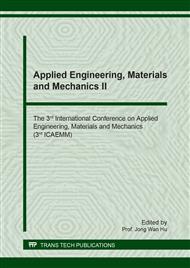p.225
p.233
p.238
p.244
p.249
p.255
p.260
p.265
p.271
Study on Seismic Performance of Space KK Type Joint of UHV Transmission Steel Pipe Tower
Abstract:
In order to study on the bearing capacity and energy dissipation capacity of the circular tubular KK-joints under the cyclic loading, the models of space KK tubular joints are established by using ABAQUS finite element software. The influence of outer diameter ratio of branch member to chord member, diameter to thickness ratio of chord member, the axial angle between branch and chord member, horizontal angle between branches and the thickness ratio of stiffeners to chord members are studied. The results show that the joints have the excellent bearing capacity and plastic deformation ability. The smaller the ratio of diameter to thickness and the axial angle of the chord, the better the hysteretic performance of the joints. The larger the ratio of the outer diameter of the chord, the transverse angle between the branches and the thickness ratio of the connecting plate to the chord, the better the hysteretic performance.
Info:
Periodical:
Pages:
249-254
Citation:
Online since:
July 2018
Authors:
Price:
Сopyright:
© 2018 Trans Tech Publications Ltd. All Rights Reserved
Share:
Citation:


